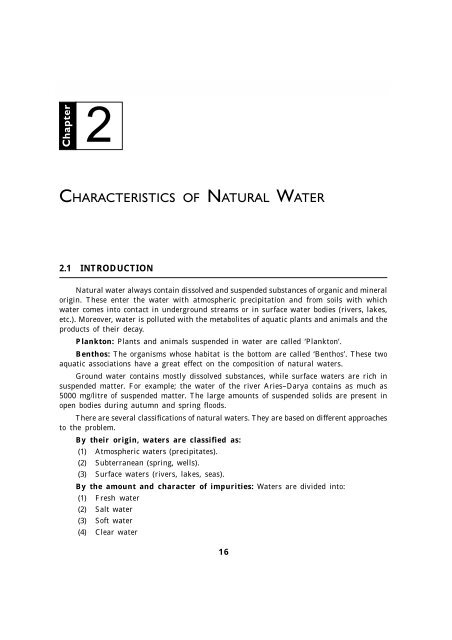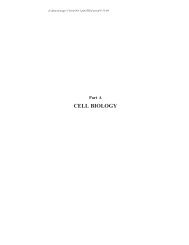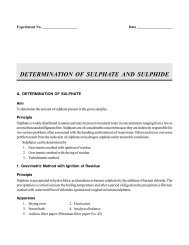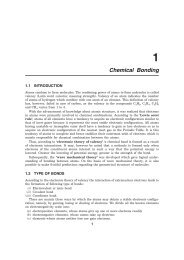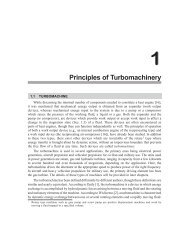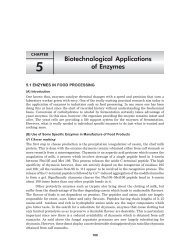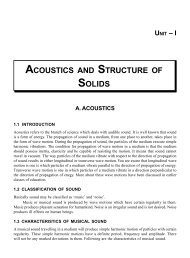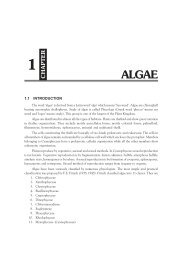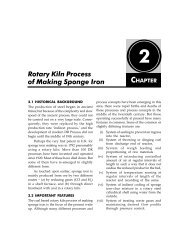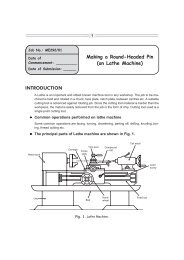CHARACTERISTICS O. NATURAL WATER - New Age International
CHARACTERISTICS O. NATURAL WATER - New Age International
CHARACTERISTICS O. NATURAL WATER - New Age International
Create successful ePaper yourself
Turn your PDF publications into a flip-book with our unique Google optimized e-Paper software.
16 CHEMISTRY OF <strong>WATER</strong><br />
Chapter<br />
2<br />
<strong>CHARACTERISTICS</strong> O <strong>NATURAL</strong> <strong>WATER</strong><br />
2.1 INTRODUCTION<br />
Natural water always contain dissolved and suspended substances of organic and mineral<br />
origin. These enter the water with atmospheric precipitation and from soils with which<br />
water comes into contact in underground streams or in surface water bodies (rivers, lakes,<br />
etc.). Moreover, water is polluted with the metabolites of aquatic plants and animals and the<br />
products of their decay.<br />
Plankton: Plants and animals suspended in water are called ‘Plankton’.<br />
Benthos: The organisms whose habitat is the bottom are called ‘Benthos’. These two<br />
aquatic associations have a great effect on the composition of natural waters.<br />
Ground water contains mostly dissolved substances, while surface waters are rich in<br />
suspended matter. For example; the water of the river Aries–Darya contains as much as<br />
5000 mg/litre of suspended matter. The large amounts of suspended solids are present in<br />
open bodies during autumn and spring floods.<br />
There are several classifications of natural waters. They are based on different approaches<br />
to the problem.<br />
By their origin, waters are classified as:<br />
(1) Atmospheric waters (precipitates).<br />
(2) Subterranean (spring, wells).<br />
(3) Surface waters (rivers, lakes, seas).<br />
By the amount and character of impurities: Waters are divided into:<br />
(1) Fresh water<br />
(2) Salt water<br />
(3) Soft water<br />
(4) Clear water<br />
16
<strong>CHARACTERISTICS</strong> OF <strong>NATURAL</strong> <strong>WATER</strong> 17<br />
(5) Colourless water<br />
(6) Opalescing water<br />
(7) Turbid water<br />
(8) Coloured water etc.<br />
By the use waters are classified as:<br />
(1) Potable water<br />
(2) Domestic water<br />
(3) Technical water (Industrial)<br />
(4) Cooling water<br />
(5) Medicinal water.<br />
The composition of natural waters usually varies with time. Mineral and organic suspended<br />
matter gradually settles by gravity. Part of the organic matter is consumed as food by the<br />
living organisms. The chemical and biological processes occurring in natural waters destroy<br />
the readily oxidizable organic substances. The formation of hydroxides of iron, manganese<br />
and aluminium and the binding of colloidal admixtures in water by these hydroxides also<br />
affect the composition of natural water.<br />
The bulk of the organic matter in natural waters are humins. Proteins, fats, hydrocarbons,<br />
carbonic acids and vitamins also occur in the water, but their presence is insignificant<br />
compared with that of organic compounds.<br />
The mineral composition of water is quite varied. Seawater is rich in dissolved substances<br />
and is unfit for drinking, or domestic and industrial uses.<br />
Salt content of sea water g/litre:<br />
Baltic Sea — 7.5<br />
Black Sea — 18.0<br />
North Sea — 32.8<br />
Pacific Ocean — 33.6<br />
Atlantic Ocean — 36.0<br />
Mediterranean Sea — 39.4<br />
Red Sea — 43<br />
The main salt contained in the water of the seas and oceans in sodium chloride (common<br />
salt). The approximate salt composition of sea water is as follows :<br />
NaCl – 83.67% MgSO4 – 3.60% KCl – 0.03%<br />
MgCl2 – 8.50% CaSO4 – 4.20%<br />
The water in some lakes is even more salty, upto 5.82 g/litre in some of the seas in<br />
Central Asia, and even 360 g/litre in Gusgundag, Transcaucasus.<br />
Mineral Water<br />
The composition of so called mineral waters is very interesting. They are absolutely<br />
unfit for industrial use but can give valuable medicinal drinks. By their composition they are
18 CHEMISTRY OF <strong>WATER</strong><br />
divided into brackish, alkaline, bitter, containing iron salts, gases and sulphides. Mineral<br />
waters contain comparatively small amounts of salts. These are river, lake, ground, artesian<br />
and spring waters. They all are drinking waters.<br />
River water usually contains from 0.05 to 1.6 g/litre of salts (more often from 0.1 to 1.2<br />
g/litre). The highest concentration of mineral salts in potable water is in the Theames (Great<br />
Britain) and Nile (Africa) which contain 1.6 g/litre dissolved salts.<br />
The Pechora and Neva (Soviet Union) contain remarkably low quantities of salts, 0.05<br />
g/litre.<br />
Swamp water contains little in the way of mineral salts but is very rich in organic<br />
matter. In some cases the concentration is as high as 850 mg/litre.<br />
When we characterize natural waters, the existence of abnormal phenomena should<br />
be mentioned. Sea water is known to be salty and unfit for drinking. But fresh water<br />
springs frequently occur in coastal areas which are often used for local water supply. The<br />
springs are great in number. They are found in Karst areas where the coasts and adjacent<br />
sea bottom are of Limestone. Atmospheric precipitation, absorbed in Karst funnels, wells<br />
and crevices, is unloaded through coastal and bottom springs. Such waters are found in<br />
the Black Sea (USSR). In 1948-55 they were discovered in the district of Gogra. When the<br />
sea is quite, the movement of water can be easily seen on the surface due to the powerful<br />
discharge from a Karst spring. Underwater springs are also found in the crimea, at the<br />
Baidar gates.<br />
2.2 <strong>WATER</strong> POLLUTANTS<br />
The impurities that occur in natural water can be classified into three groups, according<br />
to their physico-chemical properties.<br />
The First Group<br />
These are substances which completely dissolve in water. They are present in water as<br />
separate molecules or ions. This water can not be distinguished from absolutely pure water.<br />
The presence of impurities can only be detected by chemical analysis or organoleptically (by<br />
taste).<br />
Natural waters can contain solutions of many gases, e.g.; O2 , N2 , CO2 , H2S and others,<br />
soluble salts of Sodium, Potassium, Calcium, Ammonium, Magnesium Aluminium, Iron,<br />
Manganese etc.;<br />
Industrial sewage pollute water with salts of heavy metals (Cu, Pb, Mg) and with<br />
various organic substances, such as phenols, formaldehyde etc.<br />
Dissolved impurities are not retained by sand, paper or any other common filter.<br />
The Second Group<br />
Impurities belonging to this group form colloidal systems with water. The particles of<br />
these impurities consists of aggregated molecules. For example, soap particles in water
<strong>CHARACTERISTICS</strong> OF <strong>NATURAL</strong> <strong>WATER</strong> 19<br />
consist of about 50 molecules. Colloidal systems are formed from substances practically<br />
insoluble in a given liquid.<br />
The first discovered colloidal systems were starch, rubber and glues. Hence the name<br />
‘colloid’ which originates from the Greek ‘Kotla’, glue-colloidal particles are so small that<br />
they can only be seen with an electron microscope or ultramicroscope. Therefore particles<br />
are not retained by sand in setling tanks or by paper filters. But they are held by membranes<br />
of bovine bladder or colloidon.<br />
Substances of mineral origin such as SiO2 , Al(OH) 3 , Fe(OH) 3 and organic substances<br />
(humins or fulvic acid) can be contained in water in the colloidal state. The latter can colour<br />
water from yellow to brown.<br />
The Third Group<br />
Third group of pollutants from suspensions in water. These are particles of sand, clay<br />
and organic matter, which are washed from the soil by rain water, thawing snow and ice,<br />
and other run off. Pollutants of this type settle on standing. They are retained by paper and<br />
partly by sand filters.<br />
2.3 BIOLOGICAL CONTAMINATION OF <strong>WATER</strong><br />
Natural waters are rich in Bacteria, Algae, Protozoa, Worms and others organisms. The<br />
greater the amount of nutrients in water, the faster the Biological contamination develops.<br />
The most frequently occurring microorganisms are bacteria which take an active part in the<br />
formation of all aquatic populations. They inhibit sludge and other bottom grounds in large<br />
quantities and grow into intricate shapes on under water objects (periphyton). The minutes t<br />
microorganisms, they are the smallest constituents of plankton (nanoplankton). Bacteria<br />
form stable suspensions since their density is close to that of water (their cells contain about<br />
85 per cent of water).<br />
Water Plants<br />
Water plants are also an indispensable part of all aquatic populations due to their<br />
high adaptability. Aquate life includes benthic organisms inhabiting the bottom sludge,<br />
plankton living in the water bulk, and organisms developing in the surface layer of water.<br />
Underwater parts of plants, bottom stones and other objects are covered with growths<br />
in the form of crusts, pads and bushes whose colour varies depending on the<br />
composition. Water plants form ‘underwater meadows’ in water bodies rich in soluble<br />
salts of calcium.<br />
The density of plankton organisms is close to that of water. Heavy organisms develop,<br />
the ability to hover in water. They accumulate oils to form mucilage, gas vacuoles (pseudo<br />
vacuoles), chains, spirals. This increase their volume and reduces their weight. The growths<br />
of water weeds is often very intense and the water is said to ‘bloom’.
20 CHEMISTRY OF <strong>WATER</strong><br />
Water Bodies–Polluted<br />
Water bodies polluted with organic matter of plant and animal origin are a good medium<br />
for the development of protozoa. Protozoa feed on bacteria and suspended matter. Some<br />
protozoa are carnivorous, for example, Rhizopods. They prey on other protozoa, rotifers and<br />
small worms.<br />
Water bodies are inhabited by various animals which can be classified as belonging to<br />
the large group of worms. They inhabit weed groves, bottom sludge or freely forming<br />
plankton formations. Masses of aquatic weeds and sludge are inhabited by larger forms such<br />
as Leeches, long and thin oligochates (Scanty hair worms) flatworms, minute round worms,<br />
and some times hairworms which are 1–1.5 m long. Among microorganisms there are<br />
rotifers, both freely floating and living in casings which they build the nucleus. Microscopic<br />
hypotricha also reside here. Their bodies are covered with numerous fine scales topped with<br />
little thorns.<br />
Most worms are parasites. They live on the animals or in their internal organs. All<br />
aquatic animals and some groups of plants are infested with worms parasitizing on them.<br />
Even protozoa and algae harbour and nourish worms. The parasites are detrimental not only<br />
to fishes but, through them, to man as well. But freely living worms are also very useful<br />
since fish feed on them. Some representatives of the ‘tubificidae’ family are involved in the<br />
turnover of matter in water bodies by transporting organic substances from deeper layers<br />
of sludge to its surface. Along with other organisms, worms are a good indicator of the living<br />
conditions in a water body. They are used by people investigating the sanitary and biological<br />
condition of surface waters and for establishing the state of sludge and soil in rivers, which<br />
is important for various hydrotechnical constructions.<br />
Oil Pollution of Water<br />
The greatest damage to water is inflicted by petroleum and its products. Oil enters<br />
water from breakdowns on derricks, wrecks of oil tankers, accidental spillage, cleaning of<br />
fuel tanks by merchant and warships and also from sheet cleaning.<br />
According to Thor Heyevdahl (1973) more than 100,000 tons of oil are annually discharged<br />
into the Meditarranean sea. Each square kilometer of the sea surface near Southern Italy<br />
is covered with 500 liters of massout. The Sargasso sea is also so heavily polluted with<br />
massout that investigators could not take samples of plankton because the cells of their nets<br />
get clogged with massout. According to UN reports, the annual oil influx into the ocean from<br />
tankers alone is as much as million tons, while the total amount of oil that enters the ocean<br />
is ten times as great.<br />
Endanger to Aquatic Life<br />
Oil and its products endanger the aquatic life in the surface layers and also the coastal<br />
flora and fauna. Heavy petroleum products precipitate to the bottom or absorbed on rock,<br />
stone and sand banks to inhibit the life of hydrobionts one drop of petroleum spreads over<br />
a great area to isolate the water from contact with atmospheric oxygen, while continuous<br />
films inhibit photosynthesis and the formation of oxygen. This inhibits the growth of plankton,<br />
which is the main food source of the hydrobionts inhibiting the water body.
<strong>CHARACTERISTICS</strong> OF <strong>NATURAL</strong> <strong>WATER</strong> 21<br />
All aquatic animals depend, either directly or indirectly, on plankton which is the basis<br />
of the tropic chain, but plankton can develop only in depths of water to which the solar<br />
radiation penetrates. In tropics, the thickness of the surface layer is 80–100 m, and in the<br />
northern regions 15–20 m on sunny summer days.<br />
Most organisms inhabiting the surface layers are found near the shorline, where they<br />
obtain the mineral and organic substances required for their vital processes. But the surface<br />
of waters in contact with the shore is usually contaminated with oil which interferes with<br />
the normal development of many hydrobionts.<br />
2.4 SANITARY AND CHEMICAL ANALYSIS OF <strong>NATURAL</strong> <strong>WATER</strong>S<br />
The quality of Natural waters is determined by Physical and Chemical Analysis.<br />
Physical Properties of Water<br />
1. Temperature. The temperature of water depends upon the season and on the<br />
temperature of the ground with which it is in contact. The temperature of water<br />
issuing from subterranean springs is little affected by seasonal variations of<br />
temperature and is therefore almost constant. The temperature of surface waters<br />
varies within a wide range. For example, in the Neva river, it varies, within the<br />
year from 0.1 to 18°C while in the Dnieper river it fluctuates from 1 to 28°C.<br />
The optimum temperature of drinking water is between 11°C and 7°C. Water in<br />
this temperature range has a pleasant taste and is refreshing. At high temperatures<br />
water contains little dissolved gases and is therefore unpleasant to taste, nor does<br />
it queench thrust, the temperature of water is measured in degrees centigrade<br />
and at the moment of taking the sample.<br />
2. Odour and Taste. Odour and taste depend on the temperature, the dissolved gases,<br />
and on the chemical composition of impurities.<br />
Table 2.1 Effect of impurities on water<br />
Salt Concentration (mg/litre)<br />
Indefinite<br />
slight, hardly Repulsive<br />
distinguishable Taste<br />
taste<br />
NaCl 150 500 salty<br />
MgCl2 100 400 bitter<br />
MgSO4 200 500 bitter<br />
CaSO4 70 150 astringent<br />
KCl 350 700 bitter<br />
FeSO4 1.5 5.0 chalybeate<br />
MnCl2 2.0 4.0 stagnant<br />
FeCl2 0.3 0.5 stagnant
22 CHEMISTRY OF <strong>WATER</strong><br />
Odour and taste of water are due to the presence of, for example, hydrogen sulphide<br />
and the products of decomposition of vegetable plants which develop in water bodies. With<br />
time, water plants decay under the influence of special bacteria (they become rotten) and<br />
liberate substances with unpleasant odours.<br />
A refreshing and pleasant taste is given to water by the dissolved gases (oxygen and<br />
CO2 ), and also by small amounts of calcium hydrocarbonate.<br />
Determining of Odour<br />
Odour and smacks are measured on five degree scale. The character of odour is<br />
determined first :<br />
(a) Odours of natural origin (due to living and decaying aquatic organisms, the shore<br />
ground, bottom, environing soils, grounds, wall frame work etc.<br />
(b) Odours of an artificial nature (due to accidental industrial pollution, chemical<br />
reagents added to water supply systems, etc.).<br />
Table 2.2 Character of odour (first group)<br />
Symbol Character of Approximate<br />
odour identification<br />
A Aromatic Cucumber, flower<br />
S Stagnant Silt, miry<br />
P Putrefactive Fecal, sewage<br />
W Woody Odour of wet chips<br />
E Earthy Rotten, freshly ploughed soil<br />
F Fishy Cod liver oil, fish<br />
H Hydrogen sulphide Rotten eggs<br />
G Grassy Hay<br />
I Indefinite Natural odour, unclassifiable<br />
A wide neck flask of 150–200 ml capacity is two thirds filled with a water sample, at a<br />
temperature of 15–20°C, and covered with a water glass. The flask is then shaken and<br />
rotated, opened, and smelt. The odour of first group is given above.<br />
Second groups odours are named according to the chemical agent which gives the<br />
prevailing odour, e.g., Phenolic, Chlorophenolic, Camphoraceous, Benzene, Chlorine etc.<br />
The odour of chlorinated water is assessed 30 minutes after chlorination. The odour is<br />
determined (a) at 15–20°C, and (b) after heating to 60°C. The scale water odours.
<strong>CHARACTERISTICS</strong> OF <strong>NATURAL</strong> <strong>WATER</strong> 23<br />
Table 2.3 Odour intensity (in degrees)<br />
Degree Intensity Description<br />
0 None Absence of any distinguishable<br />
odour<br />
1 Very faint Odour only detectable by an<br />
experienced worker<br />
2 Faint Odour unnoticeable to an unware<br />
consumer but which can be detected<br />
after working<br />
3 Marked Odour easily detectable and giving<br />
displeasure<br />
4 Distinct Odour making water unfit for<br />
drinking<br />
5 Very strong Strong repulsive odour<br />
The water is heated in the same flask covered with a watch glass.<br />
The following rules should be observed.<br />
(a) The air in the room where the odour of the water is to be determined should have<br />
no extraneous odours.<br />
(b) The Investigator’s hands, face, clothes etc.; should emit no odour.<br />
(c) A person should not carryout routine determination for long periods of time because<br />
of human adaptability to odours and fatigability.<br />
2.5 DETERMINING TASTE AND SMACK<br />
The taste and smack of water and also their intensities and qualities are determined<br />
organoleptically.<br />
All tastes can be roughly classified into four groups ; Salty, bitter sweet and sour. All<br />
other taste sensations are smacks. Taste and smack are determined in raw water, except<br />
water from open bodies and springs which are not reliable from the sanitary stand point.<br />
Water from these sources should be boiled, cooled to room temperature, and only then its<br />
taste determined. A special note should be put in the test record : “taste or smack, of<br />
boiled water”. The taste of chlorinated water should be determined 30 minutes after<br />
chlorination.<br />
The determination is carried out on a 15 ml water sample which is taken into the<br />
mouth; held there for few seconds and spit out (swallowing is not recommended).<br />
The qualitative characteristics of smacks are : chlorine, fleshy, metal etc. The intensity<br />
of taste and smack is determined by a five degree scale similar to that used for the<br />
determination of odour.
24 CHEMISTRY OF <strong>WATER</strong><br />
2.6 CLARITY AND TURBIDITY OF <strong>WATER</strong><br />
Natural waters are often turbid due to the presence in them of suspended particles of<br />
sand, clay, silt or organic matter.<br />
The sources of turbidity of river and lake waters can be soils and rocks which are<br />
washed out by the river water from its bed and banks and also surface particles brought into<br />
the water by run off from meadows, forests, fields and towns.<br />
An accurate gravimetric determination in water is a time consuming procedure, indirect<br />
methods, namely, the determination of clarity and turbidity; are therefore used.<br />
The determination of clarity is made by : (a) Crosses or (b) Printed characters. The<br />
first method is used for routine control of the work of water treatment plants and for the<br />
determination of the quality of tap water, while the second method is used in all other<br />
cases.<br />
2.7 DETERMINING <strong>WATER</strong> CLARITY<br />
It consists of a 350 cm high cylinder, graduated in 1 cm, on the bottom of which is<br />
placed a white disc with a black cross drawn with 1 mm thick black lines and four black spots<br />
of 1 mm in diameter between the times. The bottom of the cylinder is illuminated with a<br />
strong electrical light. The greatest height of water is the column, in cm on the cylinder<br />
scale through which the cross and the spots can be distinctly seen, determines the clarity<br />
of the water by this method.<br />
Using the other method, the clarity of water is determined in a graduated cylinder held<br />
at a distance of 4 cm over standard characters. The maximum height of the water column<br />
through which the characters can be read measures clarity.<br />
If a sample of water contains less than 3 mg/litre of suspended matter, the determination<br />
becomes difficult because long columns are required. In such cases the characteristic which<br />
is the converse of clarity; namely turbidity is determined.<br />
Turbidity-Nephelometers<br />
To determine the turbidity, a turbidimeter is used for this purpose, turbidity being<br />
expressed in mg/litre. The operating principle of the apparatus is the comparison of the<br />
turbidity of a water sample with a standard. The particles of the disperse phase scatter light,<br />
and if these particles are larger than the wavelength, the light is scattered due to refraction<br />
and complete internal reflection by particles.<br />
The arrow ‘S’ indicates the direction of a light beam which is refracted at point A<br />
where it meets the particle M, thus fully reflected at a point B, and refracted against C.<br />
As a result, the path of the beam has deviated by an angle θ. Light beams scattered by<br />
the particle propagate in all directions to meet the neighbouring particles and to undergo<br />
new scattering.
<strong>CHARACTERISTICS</strong> OF <strong>NATURAL</strong> <strong>WATER</strong> 25<br />
Fig. 2.1. Scattering of light by suspended particles<br />
The scattering of light by particles of various size has been studied by Blumer and G.<br />
Pokrovsky, who established that ‘particles of equal size and shape scatter light of equal<br />
intensity’. If two turbid media containing particles of equal size and shape, and having about<br />
the same concentrates of these particles are taken, the intensity of scattered light will be<br />
directly proportional to the concentration.<br />
Nephelometers<br />
This principle underlies the design of Nephelometers which compare the turbidities of<br />
two liquids and determine the ratio of concentrations of two suspensions.<br />
One solution of known concentration is used as a standard. By comparing the two<br />
liquids, the concentration of the turbid solution in question is determined. Nephelometers<br />
are very convenient for the determination of small amounts of substances which are present<br />
in cases of slight turbidity.<br />
Tyndall Effect<br />
Particles smaller than light wavelength also scatter light but the cause is different.<br />
Reflection and refraction are absent here in the common sense of these words, and what<br />
actually takes place is the diffraction of light which comes into contact with colloidal particles.<br />
Such scattering of light is called the ‘Tyndall Effect’.<br />
Colour of Water<br />
Pure water in small volume is colourless. Through a thick layer water has a bluish hue.<br />
Other tints indicate the presence of various dissolved substances and impurities.<br />
In order to correctly assess the colour of the water. It is necessary first to identify the<br />
source of the colour.<br />
Causes for Colour<br />
The causes which can account for water colour are colloidal compounds of iron, humins,<br />
suspended matter, coloured wastes and the intense growth of water plants.
26 CHEMISTRY OF <strong>WATER</strong><br />
When water ‘blooms’ in open bodies, it becomes light green; when overgrowth with blue<br />
greens (protococcous microorganisms) water becomes emerald green.<br />
The colour of natural waters in open bodies is usually due to the presence of humins<br />
and fulvic acids, which colour water various shades, from yellow to dark brown. The colour<br />
of water is determined colorimetrically by comparing the colour of water samples with<br />
standard colours.<br />
The colour is expressed in degrees of the platinum-cobalt scale (The colour of a solution<br />
containing 2.49 g of K2PtCl6 and 2.08 g of COCl2 in 1 litre of water is assumed to be 1000<br />
conventional degrees, or of the Cobalt-bichromate scale (the colour of a solution containing<br />
0.175 g of K2Cr2O7 and 4 g of CaSO4 in one litre of water is also assumed to be 1000<br />
conventional degrees, according to the Soviet State standard.<br />
Chemical Properties of Water<br />
The chemical properties of water are very important for a practical assessment of its<br />
quality :<br />
(a) Fitness for domestic or industrial use.<br />
(b) The absence or presence of substances causing corrosion of metals and concrete,<br />
or substances which produce foam or scales.<br />
Comparing the results of chemical analysis of natural water with the requirements for<br />
pure water help the investigator to select the best method to treat the natural water.<br />
2.8 COMPLETE SANITARY CHEMICAL ANALYSIS OF <strong>WATER</strong><br />
Complete Sanitary Chemical Analysis of water compresses the following measurements.<br />
(1) Suspended solids, mg/litre.<br />
(2) Dry residue, mg/litre.<br />
(3) Residue on Ignites, mg/litre.<br />
(4) Electrical conductivity, ohm –1 × cm –1 .<br />
(5) Total Oxygen Demand, mg/litre.<br />
(6) Dissolved Oxygen, mg/litre.<br />
(7) Biochemical Oxygen Demand, mg/litre.<br />
(8) Free chlorine, mg/litre.<br />
(9) Active reaction medium, pH.<br />
(10) Acidity, mg-equiv/litre.<br />
(11) Alkalinity, mg equiv/litre.<br />
(12) Ions Ca2+ , Mg2+ , Fe2+ , Fe3+ , Mn2+ , Al3+ , Na + , K + , Cl – , SO 2–<br />
4 , PO4 3– , F –1 ,<br />
I – mg/litre.<br />
(13) Chlorine Demand, mg/litre.
<strong>CHARACTERISTICS</strong> OF <strong>NATURAL</strong> <strong>WATER</strong> 27<br />
(14) Nitrogen containing compound; nitrogen of ammonium salts (NH +<br />
4 ), nitrites,<br />
nitrates, mg/litre.<br />
(15) Hardness, mg-equiv/litre.<br />
(16) Carbon dioxide, mg/litre.<br />
(a) Total (c) Hydrocarbonate HCO –<br />
3 (e) Equilibrium acid<br />
(b) Free CO2 (d) Carbonate (f) Aggressive.<br />
(17) Silica, SiO2 , mg/litre.<br />
(18) Surface active substances.<br />
(19) Hydrogen sulphides, H2S. (20) Heavy metal ions, Pb2+ , Cu2+ , Zn2+ and Sn2+ .<br />
A complete sanitary chemical analysis gives detailed characteristics of water but it is<br />
often possible to limit the analysis to the measurements.<br />
Analysis<br />
Taking the sample is an important step in the analysis of water. The vessel in which<br />
the sample is taken should be washed throughly, revised with distilled water and then with<br />
water from the source in question. The vessel containing the sample should be tightly closed<br />
with a ground glass topper or with a new cork plug.<br />
Rubber plugs should be avoided since water can extract some mineral or organic<br />
substances from rubber. When taking samples of tap water, the first full container should<br />
be discarded.<br />
When sampling water from open bodies, the vessel should be immersed into the water<br />
so that the sludge on the bottom will not be disturbed. Extraneous objects floating on the<br />
surface should not be taken either.<br />
Five litres of water is required for a complete sanitary chemical analysis and 2 litres<br />
for a sanitary analysis.<br />
Suspended Solids<br />
By suspended solids we mean particles over 1 × 10 –4 m in size which are retained on<br />
a filter paper. These may be particles of clay, sand, various silicates etc. Suspended pollutants<br />
are found in surface waters of open bodies. The amount of suspended solid depends on the<br />
water protection in a given area and on the season. As a rule, large amounts of suspended<br />
solids get into water with thawing snow and rainfalls. Subterranean waters contain lesser<br />
amounts of suspended solids because water is separated from them as it passes through the<br />
ground.<br />
If the concentration of the solids in water is less than 100 mg/litre, they are determined<br />
photometrically (Nephelometrically) or by filtration through membrane filters. If the<br />
concentration is higher than 100 mg/litre paper, filters are used.<br />
Photometric method is based on the comparison of the sample with a standard solution<br />
in which the concentration of the suspended solids is known, standard suspensions are
28 CHEMISTRY OF <strong>WATER</strong><br />
prepared from material with which the water in question was in contact. Washed clay is used<br />
to prepare a turbidity scale. The particle size of such clays is less than 0.05 m/sec. As water<br />
is examined at water supply plants, the sludge from the settling tanks and classification<br />
units is used for preparing turbidity standards.<br />
A standard suspension is used to construct a calibration curve which shows the change<br />
in absorption depending on the concentration of the suspended solids in solutions. The<br />
absorption coefficients of the water in question are then determined and the concentration<br />
of suspended solids in the sample found from the calibration curve.<br />
The procedure for the determination of suspended solids on membrane filters is the<br />
same as with paper filters.<br />
The Dry Residue<br />
Characterises the concentration of salts and the amount of colloidal substances<br />
in water.<br />
The Residue After Ignition<br />
Refers to non volatile impurities contained in water. As a rule, subterranean waters are<br />
richer in mineral substances than surface waters, since water dissolve them as it passes<br />
through salted soils.<br />
Electrical Conductivity<br />
Chemically pure water does not conduct electricity. Any rise in the electrical conductivity<br />
of water indicates pollution with electrolytes.<br />
Oxygen Demand<br />
Oxygen demanding substances, both inorganic and organic contained in water and<br />
reacting with oxidizers characterise the total oxygen demand of water. It is expressed in<br />
milligrams of oxygen required to oxidize impurities contained in 1 litre of water.<br />
We distinguish total and Partial Oxygen Demands.<br />
Chemical Oxygen Demand (COD)<br />
Total oxygen demand is also known as chemical oxygen demand. It is determined by the<br />
Iodate Method.<br />
Iodate Method<br />
It accounts for all the organic substances contained in water. During their oxidation all<br />
carbon is burned to CO 2 , nitrogen is converted into nitric acid, sulphur into sulphuric, and<br />
phosphorous into phosphoric acid. For example, the oxidation of acetic acid with potassium<br />
iodate in an acid medium can be expressed as<br />
8 KIO 3 + 5CH 3 COOH + 4H 2 SO 4 ⎯⎯→ 4K 2 SO 4 + 4I 2 + 14H 2 O + 10CO 2
<strong>CHARACTERISTICS</strong> OF <strong>NATURAL</strong> <strong>WATER</strong> 29<br />
Partial oxygen demand is determined by the reaction with potassium permanganate<br />
KMnO4 . Only comparatively easily oxidizable substances are involved in this reaction, but<br />
the method is much simpler than the Iodate Method and is therefore more popular with<br />
analysts.<br />
The oxidation with potassium permanganate is as follows :<br />
2KMnO 4 + 3H 2 SO 4 + 5K 2 SO 3 ⎯⎯→ 6K 2 SO 4 + 2MnSO 4 + 3H 2 O<br />
The difference is the results of testing a water sample for total and partial oxygen<br />
demands indicates the presence of stable organic admixtures in the water.<br />
Oxygen Demand-Requirement<br />
The oxygen demands of naturally occurring waters depend on humins, hydrogen sulphide,<br />
sulphites, ferrous iron etc.<br />
Artesian waters are characterized by the smallest oxygen demand, about 2 mg of O2 per<br />
litre. The oxygen demands of ground waters depend on the depth of the source. The deeper<br />
the water, the lower the oxygen demand.<br />
Non polluted ground waters require about 4 mg/litre of O2 , Lake waters from 5 to<br />
0.8 mg/litre of O2 , and swamp water up to 400 mg/litre of O2 . The oxygen demand of river<br />
water varies within wide limits, viz., from 1 to 60 mg/litre.<br />
High oxygen demand of water indicates that the source is polluted requires cleaning.<br />
If the oxygen demand of water from a given source increases abruptly this indicates<br />
that it is polluted with domestic sewage, oxygen demand is clearly an important characteristic<br />
of water.<br />
Chlorine Demand<br />
Chlorine absorbing power of water, is determined by the ammonia of chlorine in mg/<br />
litre, consumed during a 30 minute contact of chlorine with a given sample of water, and<br />
the amount spent to oxidize the impurities contained in the water e.g., humins, products of<br />
decomposition of cellular tissues, protein compounds, ferrous salts, nitrates, sulphides etc.<br />
The chlorine demand of clean waters is not high, from 2.0 to 2.5 mg/litre. A sharp<br />
increase in chlorine demand indicates, as was the case with oxygen, the deterioration of the<br />
quality of a given water.<br />
Sometimes, in order to describe chlorine demand, a conventional fraction is used in<br />
which the numerator is unity, while the denominator describes the dose of chlorine required<br />
to ensure the minimum allowed concentration after a 30-minute contact of chlorine with<br />
water, equal to 0.5 mg/litre of residual active chlorine.<br />
Total Alkalinity of Water<br />
This is characterized by the presence of all hydroxyl ions capable of combining with the<br />
hydrogen ion. Alkalinity in natural water is due to the hydrolysis of salts formed by weak<br />
acids and strong bases.<br />
A – + HOH ˆˆˆ†<br />
‡ˆˆ HA + OH –
30 CHEMISTRY OF <strong>WATER</strong><br />
When a hydrogen ion is introduced into water, the equilibrium is shifted to the right,<br />
and the salt is completely hydrolysed. The number of milligram equivalents of acid used to<br />
neutralize the hydroxyl ion contained in 1 litre of water is called ‘Alkalinity’.<br />
The alkalinity of natural waters depends largely from the presence of carbonates and<br />
hydrocarbonates, while coloured waters can also contain humates (salts of complex organic<br />
acids, humic and fulvic acids, entering the water from soil or sludge).<br />
Determination of the ‘Humate’ Alkalinity<br />
Organic acids are weak electrolytes and can therefore be displaced from salts with<br />
excess mineral acid. This property is the basis of the method used to determining ‘humate<br />
alkalinity’.<br />
A sample of water is first tested for total alkalinity with methyl orange, next 1 ml of<br />
0.1 N hydrochloric acid is added, the sample is boiled for 2-3 minutes and cooled in a jet of<br />
water. The solution is titrated with 0.1 N NaOH solution in the presence of two indicators.<br />
The first indicator, methyl orange is used to indicate the end point of neutralization of the<br />
remaining mineral acid (The solution colours yellow at pH 4.4). Then, weak organic acids<br />
are titrated with phenolphthalein untill the solution colours pink (pH-8).<br />
The number of mg equivalents of alkali used in the titration of the sample with<br />
phenolphthalein and recalculated for one litre is equivalent to the ‘humate alkalinity of<br />
natural water’.<br />
Nomogram for determining three forms of Alkalinity HCO –<br />
3 , OH – , CO3 2– .<br />
Fig. 2.2<br />
Determination of the Hydrate, Carbonate and Hydrocarbonate Alkalinity<br />
Forms of alkalinity are determined in practice from nomograms, based on the total<br />
alkalinity and the pH of a given sample of water.
<strong>CHARACTERISTICS</strong> OF <strong>NATURAL</strong> <strong>WATER</strong> 31<br />
For example, let us determine the concentration of free and hydrocarbonate alkalinity<br />
in a sample of water if its pH is 10 and the total alkalinity is 1.6 mg/litre to that end draw<br />
a straight line to connect the points on the curves corresponding to the given values. The<br />
result will show the free and hydrocarbonate alkalinity [OH – ] = 0.2 mg/litre, [HCO 3 – ] = 0.5<br />
mg/l [CO 3 2– ] = 0.9 mg/l.<br />
Corrections Coefficients β, , γ and α<br />
Coefficient β<br />
pH Dry residue mg/l<br />
50 100 200 300 400 500<br />
8 1.00 1.00 1.00 1.00 1.00 1.00<br />
9 0.99 0.99 0.98 0.97 0.97 0.96<br />
10 0.98 0.95 0.90 0.87 0.85 0.83<br />
11 0.96 0.91 0.84 0.80 0.76 0.73<br />
Coefficient γ<br />
8 1.04 1.11 1.25 1.24 1.39 1.39<br />
9 1.04 1.09 1.18 1.24 1.30 1.34<br />
10 1.02 1.05 1.09 1.12 1.14 1.16<br />
11 1.00 1.00 1.01 1.02 1.02 1.02<br />
Coefficient δ is the same for all pH<br />
1.03 1.06 1.10 1.13 1.16 1.19<br />
The results obtained from nomograms are valid only for concentrations of salts not<br />
higher than 20 mg/l. Corrections should be introduced for higher concentrations i.e., the<br />
result should be multiplied by the corresponding coefficient : β – for hydrocarbonate alkalinity,<br />
γ – for carbonate and α for hydrate alkalinity.<br />
Hardness of Water<br />
The total hardness of water is the concentrations of Ca 2+ and Mg 2+ ions expressed in<br />
mg/litre. Total hardness is determined complexometrically by titration with Trilon B. The<br />
method utilizes the property of Trilon B of making stable, low dissociated complexes with<br />
ions of calcium and magnesium.<br />
The Active Reaction of the Medium<br />
The pH of most natural waters is close to neutral (6.8–7.3). The constancy of pH in<br />
natural waters is maintained by the presence in it of buffer mixtures. If the pH of a given<br />
sample of water is not neutral. It indicates that the water is polluted with products of the<br />
degradation of organic compounds, chemical effluents from chemical and other plants.
32 CHEMISTRY OF <strong>WATER</strong><br />
The alkalinity of water is due to the presence of hydrocarbonates of calcium and<br />
magnesium, while the acidity of water depends on the hydrolysis of salts formed by weak<br />
bases and strong acids contained in water.<br />
Nitrogen Compounds: (Ammonium Salts, Nitrites and Nitrates)<br />
They appear in water mainly through the decomposition of proteinous compounds<br />
entering a water body with domestic and industrial sewage. Ammonium, nitrogen of mineral<br />
oxygen, formed by the reduction of inorganic nitrogen compounds, is rare in water. If<br />
ammonia is formed in water due to the decay of proteins, the water can not be used for<br />
drinking.<br />
The presence of nitrogen containing pollutants in water indicates its pollution with<br />
domestic sewage. If the water has been polluted only recently, all nitrogen is as a rule in<br />
the form of ammonia. If nitrites are found along with a NH +<br />
4 ion, it indicates that some time<br />
has passed since the pollution. If all nitrogen is present in the form of nitrates a long time<br />
has passed since the pollution and water has purified itself.<br />
The above processes are connected with the life of microorganisms of two types. The<br />
microorganisms of the first type (nitrite bacteria) comparatively quickly oxidize the NH +<br />
4 ion<br />
into salts of nitrous acid, while the second type of microorganisms (nitrate bacteria) oxidize<br />
nitrites in the presence of large amounts of oxygen (usually at the end of the oxidation<br />
processes).<br />
Chlorine Compounds<br />
Chlorides are readily soluble in water and the chloride ion is therefore present in<br />
almost all waters. Magnesium chloride (MgCl2 ) and sodium chloride (NaCl) have the highest<br />
solubility (545 and 360 g/litre respectively).<br />
The presence of many chlorides in water could be the result of the washing out of salts<br />
from the ground or by the discharge of domestic sewage into the river. If the water is<br />
contaminated with sewage, it contains increased amounts of chloride ion and also ammonia<br />
and nitrites, its oxygen and chlorine demand are increased and there are other indications<br />
of water pollution.<br />
Sulphates<br />
The sulphate ion SO 2–<br />
4 occurs in natural waters along with the chloride ion. It enters<br />
the water through the dissolution of sedimentary (stratified) rock containing Gypsum.<br />
Sometimes, the SO 2–<br />
4 ion is formed by the oxidation of hydrogen sulphide or nature sulphur.<br />
Industrial sewage is another source of this ion.<br />
The sulphate ion content of water in rivers and fresh water lakes does not exceed<br />
100 mg/litre.<br />
The presence of large amounts of sulphates in water is undesirable since Na2SO4 interferes with the normal function of the intestine, while CaSO4 and MgSO4 give sulphate<br />
hardness to the water.
<strong>CHARACTERISTICS</strong> OF <strong>NATURAL</strong> <strong>WATER</strong> 33<br />
Water containing large quantities of chlorides and sulphates is corrosive. Chlorides<br />
destroy concrete by extracting calcium (as CaCl 2 ).<br />
Iron and Manganese<br />
The ions of iron and maganese occur in natural waters as hydrocarbonates, sulphates,<br />
chlorides and phosphates while iron occurs also in the humic complex.<br />
A good deal of iron is contained in chalybeate waters, where its content can be as high<br />
as 100 mg/litre. Normal natural waters contain iron quantities of no more than a few<br />
milligrams per litre.<br />
The presence of iron and manganese salts in water give it an unpleasant taste and<br />
make it unfit for drinking or for industrial and domestic use. Iron salts colour water brown.<br />
This water can not be used for laundering since it stains fabric. Moreover, ferrous and<br />
manganous salts promote the growth of specific bacteria in water. Their colonies, and also<br />
the products of their metabolism, clog pipes, interfering with the flow of liquids through<br />
them.<br />
The manufacture of cinema films, paper, silk and some other products, requires specially<br />
pure water. Water must not contain even traces of iron.<br />
Silicic Acid<br />
The presence of silicic acid in water does not impair its taste or adversely affects its<br />
sanitary properties. Small doses of silicic acid in water does not impair its taste or adversely<br />
affect its sanitary properties. Small doses of silicic acid are harmless to man or animal.<br />
The acid is sparingly soluble in water and its content in natural water does not exceed<br />
30–40 mg/litre. It enters water through the dissolution of some silicates.<br />
Silicic acid should not be present in boiled water. The acid is distilled with steam, from<br />
which it condenses onto cold parts of the equipment to form a dense and strong deposit.<br />
Dissolved Oxygen<br />
Water must be tested for the presence of dissolved gases when one wants to<br />
determine its corrosive properties towards metal or concrete gases should also be<br />
determined in boiler water. Oxygen enters water from the air and it can also be formed<br />
in water by weeds growing close to the surface. The solubility of oxygen produced by<br />
green plants in water is five times greater than that of oxygen from the air, where the<br />
proportion of the gas is 21 percent (the solubility of oxygen in water depends on the<br />
partial pressure of oxygen).<br />
The oxygen concentration in water depends on its temperature and the degree of<br />
pollution. The maximum possible oxygen concentration in water (during dissolution of air)<br />
is 14.56 mg/l at 0°C.<br />
The presence of water reductants, such as ammonia, ferrous iron nitrates, readily<br />
oxidizable substances and others, upsets the equilibrium upon which the solubility of air<br />
oxygen depends and reduces its concentration.
34 CHEMISTRY OF <strong>WATER</strong><br />
Table 2.4 Dissolved oxygen in water at various temperatures<br />
Water Oxygen Water Oxygen Water Oxygen<br />
temperature content temperature content temperature content<br />
at °C<br />
ml/l mg/l<br />
°C<br />
ml/l mg/l<br />
°C<br />
ml/l mg/l<br />
0 10.19 14.56 11 7.67 10.99 21 6.23 8.90<br />
1 9.91 14.16 12 7.52 10.75 22 6.11 8.73<br />
2 9.64 13.78 13 7.35 10.50 23 6.00 8.58<br />
3 9.39 13.42 14 7.19 10.28 24 5.89 8.42<br />
4 9.14 13.66 15 7.04 10.06 25 5.78 8.28<br />
5 8.91 12.73 16 6.89 9.85 26 5.67 8.11<br />
6 8.68 12.41 17 6.75 9.65 27 5.56 7.95<br />
7 8.47 12.11 18 6.61 9.45 28 5.46 7.81<br />
8 8.20 11.81 19 6.48 9.26 29 5.36 7.67<br />
9 8.06 11.52 20 6.36 9.09 30 5.26 7.52<br />
10 7.69 11.25<br />
The difference between the oxygen content is given in the table and its actual<br />
concentration in water at a given temperature is known as the ‘oxygen deficit’.<br />
Winkler suggests that the following formula should be used to determine the dissolved<br />
oxygen in deeper layers of water and at other atmospheric pressures.<br />
C(B − P + h)<br />
C1 =<br />
760 − P<br />
Where ‘B’ is the Barometric pressure, in mm Hg; C is the oxygen concentration in a<br />
saturated surface layer, mg/litre : C1 is same for the layer at depth 1 + ; P is the partial<br />
pressure of water at a given temperature in mm Hg ; and h is the half pressure of water<br />
column (H2 ) in mm Hg. (For example; for a depth of 3 m, the half pressure of a water<br />
column is 111 Hg).<br />
The rate of oxygen dissolution in water (at constant temp.) is directly proportional to<br />
the oxygen deficit. This holds for water free from surface film. If deep layers of water are<br />
to be saturated with oxygen, the water must be stirred. The oxygen deficit in water overtime<br />
‘t’ can be calculated from the formula Dt = D0 × 10 –K2t ; K2 is the velocity constant of oxygen<br />
dissolution, which depends on the particular gas, temperature and the conditions of the<br />
surface of the liquid, σ, and the stirring conditions.<br />
[O2 ] = 12.3 – 0.047 Σt5 where Σt5 is the sum of mean daily temperatures of the air during the preceding five days.<br />
A sharp decrease in the concentration of oxygen in water compared with its normal<br />
content indicates that the water is contaminated with reductants.<br />
Water used for boilers should be free from oxygen, since it causes corrosion of the<br />
equipment at high pressures and temperatures.
<strong>CHARACTERISTICS</strong> OF <strong>NATURAL</strong> <strong>WATER</strong> 35<br />
Biochemical Oxygen Demand (BOD)<br />
If is the quantity of oxygen, in milligrams/litre used in the oxidation of impurities in<br />
water by biochemical processes occurring in it BOD characterizes the concentration in water<br />
of organic substances to which microorganisms can adapt themselves. Oxygen is used up in<br />
the processes connected with their metabolism.<br />
Hydrogen Sulphide (H 2 S)<br />
H 2 S present in water due to the microbiological decomposition of proteins, reduction of<br />
gypsum rock, or from sulphides (hydrolysis). The maximum hydrogen content of water does<br />
not exceed 10 parts of milligram in one litre. Its presence in water is harmful for fish, and<br />
the water smells rotten. Hydrogen sulphide sharply decreases the dissolved oxygen content<br />
in water.<br />
Carbon Dioxide<br />
CO 2 enters water through the decay of organic remnants in water and soil. The maximum<br />
content of carbon dioxide in surface water is 20 mg/litre and in non mineralized subsoil<br />
waters upto 40 mg/litre.<br />
Iodids and Fluorides<br />
When selecting a source of water for domestic purposes and drinking, water should be<br />
tested for iodides and fluorides. A deficit of these salts in drinking water is detrimental to<br />
man and causes serious diseases. The daily requirement of iodides is 300 mg/litre.<br />
Fluorides<br />
The human body is very sensitive to fluorides in the diet. Their import is conformed<br />
by the presence of fluorides in bone tissues and tooth enamel. Fluorine deficiency in drinking<br />
water (below 0.7 mg/litre) causes tooth caries. At the sametime excess fluorine (over 1.5<br />
mg/litre) causes fluorosis (mottled tooth enamel).<br />
The optimum dose is within a narrow range, from 0.7 to 1.5 mg/l. If water lacks the<br />
necessary amount of fluorides, they are added artificially.<br />
Heavy Metal Ions<br />
These metal compounds are usually poisonous and get into water with industrial effluents<br />
and municipal sewage.<br />
Arsenic and poisonous cyanides enter water with the sewage of tanning dye staff<br />
producing, cotton printing and metal working plants.<br />
Synthetic Surface Active Substances (Surfactants)<br />
These are the substances which affect (usually reduce) surface tension. These comprise<br />
also surface active substances obtained artificially (by synthesis). They are contained in the
36 CHEMISTRY OF <strong>WATER</strong><br />
surface layers in greater concentrations than in the inner parts of liquid. Surfactants which<br />
form micellar colloids (Colloidal Electrolytes) are the most important ones. These are open<br />
chain organic compounds containing from 10 to 20 carbon atoms. Their molecules also<br />
contain hydrophobic radicals and hydrophilic groups characterized by a certain optimum<br />
balance of hydrophilic and hydrophobic properties.<br />
Types of Surfactants<br />
Depending on their properties, synthetic surfactants are classified as Ionogenic and non<br />
Ionogenic. Ionogenic synthetic surface active substances are salts of falty, alkylsulphuric,<br />
alkylphosphoric acids, alkyl ammonium bases, which practically completely dissociate into<br />
Ions.<br />
Esters comprising chains of hydrophilic ethoxy groups, type Cn H2n+1 , COO(CH2CH2O)mH, (where n is from 6 to 18, m can vary from a few units to hundred) are nonionogenic synthetic<br />
surfactants. The –CH2O– parts of the chain are hydrophilic and –CH2 – are hydrophobic.<br />
Synthetic surfactants are much used as flotation agents, stabilizers detergents etc.<br />
The detergent action is complicated colloidal—chemical process comprising the reduction<br />
of surface energy, dispersion, colloidal, protection and solubilizations.<br />
Detergents are synthetic surfactants of a special type. In addition to stray surface<br />
activity and wetting power, they have a high stabilizing affect on hydrophobic particles of<br />
dirt. The washing action is in two stages : wetting the surface during which dirt particles<br />
pass into the liquid, and stabilizing these particles to preclude their sticking together and<br />
reprecipitating on the surface.<br />
Synthetic surfactants are widely used for domestic and industrial purposes. When<br />
synthetic surfactants get into natural water bodies they form films on the water surface to<br />
interfere with normal aeration and inhibit self purification of water from other pollutants.<br />
Large amounts of synthetic surfactants in sewage interfere with the normal operation of<br />
sewage treatment plants (primary setting tanks) inhibit the biochemical processes on biological<br />
oxidizers and promote foaming. Sanitary regulations therefore stipulate that the allowable<br />
concentration of synthetic surfactants in sewage intended for complete biological purification<br />
should not exceed 20 mg/litre for Ionogenic and 50 mg/litre for non Ionogenic surfactants,<br />
provided the sewage is first mineralised biologically to 80 and 90 percent respectively. If the<br />
sewage contains both Ionogenic and non-Ionogenic surfactants then total concentration should<br />
not exceed 20 mg/litre. If synthetic surfactants cannot be treated biologically they should not<br />
be allowed in the general sewage system.<br />
2.9 REQUIREMENT FOR <strong>WATER</strong> QUALITY<br />
Depending on the requirements, water can be classified as follows:<br />
1. Potable water: Water for cooking and drinking.<br />
2. Cooling water (cooling of machinery, liquid and gas products in condensers and<br />
coolers).
<strong>CHARACTERISTICS</strong> OF <strong>NATURAL</strong> <strong>WATER</strong> 37<br />
3. Water for boilers.<br />
4. Technical water used at various stages in the manufacture of papers, textiles,<br />
leather etc.<br />
5. Irrigation water.<br />
Depending on the purpose, the physical, chemical, and bacteriological properties of<br />
water should meet special requirements. These determine the selection of water supply<br />
sources, the technology of water processing and the layout of sewage treatment plants.<br />
Requirements for Drinking Water<br />
Bacteriological Characteristics:<br />
1. Total number of bacteria in 1 ml of nondiluted water should not exceed .... 100.<br />
2. The number of bacteria of the E. coli type, Bacteria concentration on membrane<br />
filters in 1 litre of water (Coli Indicator) should not exceed .... 3.<br />
3. In examination of liquid media accumulating coli titre, should not be less<br />
than .... 300.<br />
Note:<br />
Toxic chemicals in water<br />
(Allowed concentrations of chemicals in water)<br />
Beryllium, mg/litre 0.0002<br />
Molybdenum, mg/litre 0.5<br />
Arsenic mg/litre 0.05<br />
Nitrates mg/l 10.0<br />
Polyacrylamide mg/l 2.0<br />
Lead, mg/l 0.1<br />
Selerium, mg/l 0.001<br />
Stronlium, mg/l 2.0<br />
Fluorine, mg/l<br />
Uranium, naturally occurring<br />
0.7 (depending on climate)<br />
and U238 , mg/l 1.7<br />
Radium, 226, curies/litre 1.2 × 10 –10<br />
Strontium, curies/l 4.0 × 10 –10 .<br />
1. If, for local reasons, water is fluorinated, its fluorine content should be within the limits<br />
of 70-80 percent of the specified norm.<br />
2. If silver (Ag + ) is used for the preservation of water, the ion content should not exceed<br />
0.05 mg/l.<br />
3. If several toxic substances are revealed in water (except fluorides, nitrates and radio active<br />
substances) the total concentration, expressed infractions of the maximum allowed<br />
concentration of each individual toxic substance, should not exceed 1 mg/l.
38 CHEMISTRY OF <strong>WATER</strong><br />
Use the following formula for calculations :<br />
C1 C2 Cn<br />
+ + ...... + ≤1<br />
C C C<br />
1 2 n<br />
where C1 , C2 ... Cn are the concentration to be measured mg/litre ;<br />
and C1 , C2 ... Cn are specified standard concentrations, mg/litre.<br />
2.10 ORGANOLEPTIC <strong>CHARACTERISTICS</strong><br />
These should meet the following requirements :<br />
Odour, at 20°C and with heating to 60°C degrees .......... 2 max<br />
Smack, at 20°C, degree ....................................................... 2 max<br />
Colour, on platinum-cobalt scale, degrees ........................ 20 max<br />
Turbidity on standard scale mg/l ....................................... 1.5 max<br />
pH .......................................................................................... from 6.5 to 8.5<br />
If taste affecting substances are found in water (sulphates, chlorides) their total<br />
concentration, expressed in fractions of the maximum allowed concentration of each individual<br />
substance should not exceed 1.<br />
Dry residue, mg/l ................................................................. 1000.0<br />
Chlorides (Cl – ), mg/l ............................................................ 350.0<br />
Sulphates (SO 2–<br />
4 ) mg/l ........................................................ 500.0<br />
Iron (Fe2+ , Fe3+ ), mg/l ........................................................ 0.3<br />
Manganese (Mn2+ )................................................................ 0.1<br />
Copper (Cu2+ ) mg/litre ........................................................ 1.0<br />
Zinc (Zn2+ ), mg/litre ............................................................ 5.0<br />
Residual aluminium (Al3+ ) .................................................. 3.5<br />
Phosphate (PO 3–<br />
4 )................................................................ 3.5<br />
Total hardness ...................................................................... 7.0<br />
1. Process of Sugar. Water used in the processing of sugar should be free of organic<br />
substances highly susceptible to decomposition in order to preclude fermentation<br />
in diffusers. The level of salts should be at a minimum since their presence<br />
interferes with the boiling and crystallizing of sugar.<br />
2. Manufacture of Beer. Water used in the manufacture of beer should be free of<br />
calcium sulphate, CaSO4 , which inhibits malts fermentation.<br />
3. Alcoholic Liquors. Water used in the manufacture of alcoholic liquors should be<br />
free of chlorides of calcium and magnesium since they inhibit the growth of yeast.<br />
Other branches of food industry have their own individual requirements for the quality<br />
of water.
<strong>CHARACTERISTICS</strong> OF <strong>NATURAL</strong> <strong>WATER</strong> 39<br />
Cooling Waters<br />
Untreated natural water is normally used for cooling purposes. The requirements for<br />
cooling water are: (a) as low a temperature as possible (b) the lowest possible temporary<br />
hardness (c) least possible amounts of suspended matter, particularly of organic origin<br />
(d) insignificant permanent hardness. It must not corrode the equipment.<br />
Suspended matter is especially undesirable, since it combines with compounds causing<br />
temporary hardness, and so form deposits on the walls of heat exchange apparatus.<br />
If the temperature drop in condensers is insignificant, organic matter contained in water<br />
provides the conditions for the growth of microorganisms whose propagation can clog the pipes.<br />
Boiler Waters<br />
Water for boilers should meet the following requirements:<br />
(a) The lowest possible total hardness.<br />
(b) The lowest possible permanent hardness.<br />
(c) The lowest possible silicic acid content.<br />
(d) The water should be free from substances promoting the formation of stable foams<br />
(oils, resinous or organic matter).<br />
(e) The water should be free from dissolved gases (CO2 , O2 ) free acids and magnesium<br />
chloride (MgCl2 ).<br />
(f) The minimum allowed quantity of boils in feed water for medium pressure boilers<br />
is 2 mg/l and for high pressure boilers upto 1 mg/litre.<br />
(g) The oxygen content of water for low pressure boilers should not exceed 3 mg/l<br />
oxygen in the water inadmissible for medium and high pressure boilers.<br />
The strict requirement on the absence of oil is explained by the fact that they cause<br />
foaming of water, while oxygen corrodes the equipment.<br />
Technical Water<br />
The requirements for technical water depends on the purpose for which it is to be used.<br />
For example: The cinema film, textile, and paper industries require that water should be<br />
free from iron, manganese, silicic acid, and only limited quantities of chlorides, organic<br />
matters etc. are allowed.<br />
Water used in the manufacture of man made fibres should not use more than 2 mg/litre<br />
of O2 for its oxidation. It must be soft (0.17 to 0.64 mg/l) and its iron content should not<br />
exceed 0.03 mg/l.<br />
Water used in silk manufacturing and dyeing factories should be completely free from<br />
iron (not even traces should be evident) and organic matter.<br />
The tanning requires soft water, because the salts responsible for the hardness of water<br />
deteriorate tanning agents. Putrefaction bacteria and fungi impair the strength of tanned<br />
leather and their presence in water is therefore inadmissible.
40 CHEMISTRY OF <strong>WATER</strong><br />
Foliage, water weeds etc. should be absent from water used in the manufacture of<br />
starch, since they colour in brown. Iron should also be absent because it colours starch<br />
yellow.<br />
Irrigation Water<br />
This is used in agriculture and should not contain salts in quantities greater than<br />
1.5 g/litre.<br />
Excess salts in soils are detrimental to crops. Large quantities of Na + ion are especially<br />
harmful to plants.


